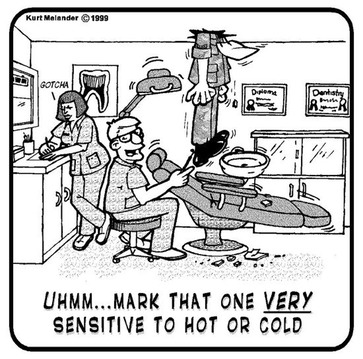My Tooth Hurts!
Well, this is a very important test that tells us a lot about the health of your tooth. Dr. McAdams considers the following possibilities when looking at a toothache to determine how to proceed:
FIRST WE RULE OUT THE OBVIOUS SOLUTIONS:
1. Have you had a cold or allergies recently? Many tooth aches are caused by sinus pressure because the roots of your top back teeth are very close to your sinuses. If all else is normal, this type of toothache can be treated with over the counter sinus medication.
2. Do you have something stuck in your gums? It can be very difficult to tell if your tooth pain is coming from your tooth or your gums, but we often find things wedged in the gums and removal of it can relieve your toothache. We find all kinds of things from broken toothpicks to popcorn husks in there.
3. Do you have gum recession? Many times an overzealous brusher will cause themselves gum recession and this can cause minor sensitivity to temperature changes. In this case, the patient can relieve the issue by using a sensitive formula toothpaste to desensitize the exposed root surfaces. (It might take a couple weeks to kick in).
4. Is the tooth cracked or decayed? At times a piece of the tooth can be missing, and it might expose the sensitive inside layer of the tooth. This can require a simple filling to solve the problem, but the fix may warrant extraction depending on how close to the gums the crack gets. If this is the case, get it fixed quick!
The cold test tells us the overall health of the tooth, and how to treat the problem. Generally a toothache proceeds like so:
1. A healthy tooth with no cavities, cracks or issues has what we call a "vital pulp." Cold stimulus on a vital tooth will cause an immediate reaction that will immediately dissipate when the cold is removed. The reaction shouldn't be terribly painful, but you should know your tooth touched something cold.
2. Minor pain will develop in response to damage. In this case the toothache is causing nerve irritation. If the tooth is highly sensitive but the pain does not linger for a while after it starts this is called "reversible pulpitis" and the tooth can be fixed at this point with a minor procedure. Think of this as a red flag, its time to see a dentist.
3. Major pain will then develop if the problem goes untreated and the tooth starts to respond to cold in a very painful way. At this point, the pain will linger after the cold is gone and this tells us that the nerve in the tooth is damaged beyond the point that it will heal. This is caused "irreversible pulpits." Unfortunately, at this point a root canal is needed if the tooth is to be saved.
4. Suddenly the toothache goes away. Now the tooth can't feel cold at all and the test gives us no response. At this point most people think they dodged the bullet and that they will no longer need dental treatment. What they don't know is that the nerve has now died and the diagnosis now is "necrotic pulp." At this point, bacteria have killed the tooth and are now using the nerve of the tooth as a food source brew a large infection. After a few months of unchecked infection, the symptoms will return because the infection slowly deteriorates the bone around the tip of the tooth until the pain returns along with swelling, draining infection, and a terrible odor/taste in some cases. Depending on how long the infection goes untreated, patients may find themselves hospitalized by an infection that migrates to the heart, or worse, the brain. At this point, an antibiotic can relieve symptoms temporarily but treatment is absolutely necessary.
For more information, read about root canals on the ADA website:
https://www.mouthhealthy.org/all-topics-a-z/root-canals.aspx/
Dr. McAdams recommends seeking treatment for a toothache as soon as you can. Because the symptoms are difficult to identify on your own, he suggests you find a dentist you can trust and sort out the cause of the pain as a team. If you are looking for a Phoenix based dentist consider visiting our office. We would love to meet you!





 RSS Feed
RSS Feed